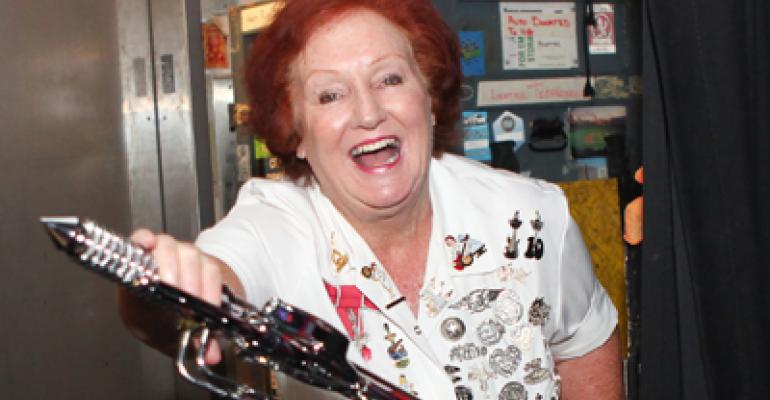Long-term employees offer an outstanding asset to a hospitality company, but the challenge of retaining those workers in a post-recessionary landscape has grown more intense, experts say.
Orlando, Fla.-based Hard Rock International has such an asset in Rita Gilligan, who was hired among the first waitresses when the Hard Rock Café opened in London June 14, 1971, and remains a prime example of the benefits of tenure and retention.
As Hard Rock celebrates its 40th anniversary, Gilligan, now 70, continues to work with the company as a brand ambassador, attending events and offering sage advice to younger workers.
VIDEO: Rita Gilligan offers her top tips for wait staff:
“Every day is still fun,” said Gilligan, whom the Queen of England honored as a Member of the Order of the British Empire for her contributions to tourism.
“She’s still inspiring to all generations,” said Kim Creighton, vice president of human resources for Hard Rock International, who herself has been with the company 21 years.
But Gilligan remains an anomaly for the hospitality business, especially after the recession, said David Mansbach, partner in the HVS Executive Search for North America.
“Up and down the organization, from the CEO down to the unit-level staff, in the last cycle too many companies really didn’t take care of their employee base,” Mansbach said. “They cut-cut-cut and took the mentality of ‘You should be lucky you have a job.’ What it has done has given me the chance to recruit very high performers, who for years had told me they wouldn’t consider other opportunities. That has created a lot of turmoil in the restaurant and hotel business especially.”
Creighton said retention is highly valuable in the service industry, and she employs a number of tools to help keep people longer.
“It’s being able to give employees various opportunities to do various things,” Creighton explained. “We are at core a restaurant company, but we do have the retail element and music is part of our DNA. They can also be part of a training team when are opening in various parts of the world or parts of the country. They may have one role with us, but they have a lot of opportunities. It’s not just coming to work and doing the same thing every day.”
Salaries are important, Creighton added, but they aren’t entirely what help retain employees.
“We pay our people competitively, but it’s how the company values the employee,” she said. “It’s much more than a paycheck, whether it’s a ‘You Rock’ pat-on-the-back thank you for something they did or recognizing them by giving them a Rolex [watch] after they’ve been with us for 10 years.”
Among Hard Rock’s co-owned or managed cafes, the number of employees with more than 10 years of tenure are 622, with 496 of them being staff and 126 managers, the company said.
Creighton also said restaurants need to do a good job of helping employees understand this can be a career. “And it’s also about having those long-term employees mentor and train the new ones coming in to really get them in alignment with what we’re about,” she said.
Mansbach said he sees many companies under-valuing the importance of long-term employees.
“It’s obviously critical to any business,” he said. “As you get down the organization chart to managers and unit-level employees, these individuals are the key touch point between corporate, which is the internal customer, and the external customer.
“There’s such value in these people,” he added, “not only being there for a while, but for being ambassadors of the brand for customers and for recruiting — bringing their friends in to work.”
While companies have both monetary and non-monetary retention tools, Mansbach said he sees the latter being under-utilized.
“Believe it or not, I think the non-monetary items, based on the informal studies I have done are more important than monetary,” he said. “It’s recognition. It’s career progression. It’s the ability to give them a sense they truly add value to the organization.”
To find out more about what rewards will work, restaurant leaders must “spend time really going to these employees and really asking what they value in the form of reward,” Mansbach advised. Such a reward could be something as simple as a lunch with the chief executive, he said.
“Some companies really spend a lot of time with their employee base, really getting in and understanding what they are looking for,” he said. “It’s a simple idea … Talk to your employees and understand what they are looking for in both the short and long term. And customize the programs. What is right for one general manager may not be right for another general manager. It’s a simple solution, but not many people do it.”
Contact Ron Ruggless at [email protected].
Follow him on Twitter: @ronruggless

